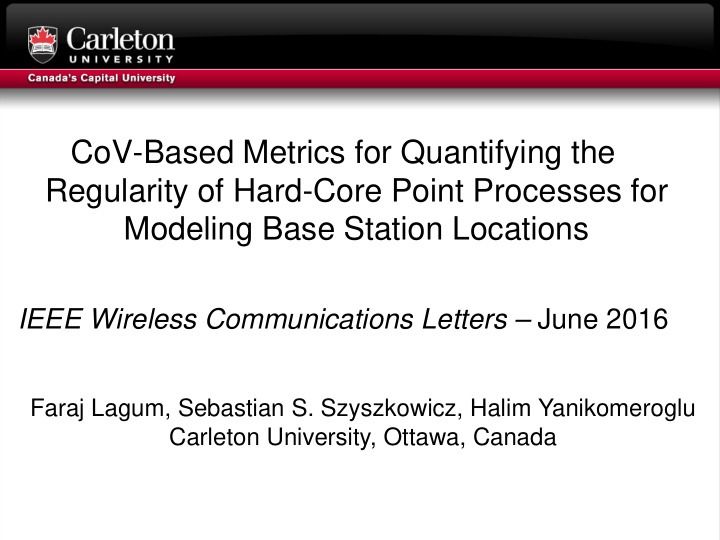



CoV-Based Metrics for Quantifying the Regularity of Hard-Core Point Processes for Modeling Base Station Locations IEEE Wireless Communications Letters – June 2016 Faraj Lagum, Sebastian S. Szyszkowicz, Halim Yanikomeroglu Carleton University, Ottawa, Canada
Motivation Q: Are these two Base station (BS) locations similar in terms of regularity and network performance?
Motivation Q: Are these two Base station (BS) locations similar in terms of regularity and network performance? A: Yes, they are alike in terms of regularity and signal-to- interference ratio (SIR) distribution!
Motivation Q: Are these two Base station (BS) locations similar in terms of regularity and network performance? (b) & (c) are alike in terms of regularity and SIR distribution (a) & (d) are different in terms of regularity and SIR distribution
How can we compare spatial patterns? Functional summary characteristics, for example: - the nearest neighbour distribution function - the empty space function - the Ripley’s K-function These functional metrics are not enough since we still need to quantify the difference between them There was no adequate scalar metric to describe the spatial structure of these BSs
Contribution We introduce an adequate scalar metric to describe the spatial structure of these BSs. M. Mirahsan, R. Schoenen, H. Yanikomeroglu, “HetHetNets: Heterogeneous traffic distribution in heterogeneous wireless cellular networks”, IEEE JSAC , vol. 33, no. 10, pp. 2252-2265, Oct. 2015 We show that the CoV-based metrics are capable of measuring the amount of regularity in RPPs (repulsive point processes). We compare the hard-core point processes as models for BS locations in terms of the achievable range of regularity.
Contribution Why do we need a scalar metric for regularity? • To compare the performance (e.g., SIR) of different spatial patterns as models for BS locations. • 3.4 dB SIR gain between triangular lattice and Poisson point process (PPP) deployments with the same density [Rayleigh fading, path-loss exponent=4, no shadowing, no noise] (Haenggi, 2014). • Describe BS distribution using two scalars: Density and Regularity. • Tune the internal parameters of a point process.
Regularity CoV-Based Metrics The coefficient of variation (CoV) of three geometric properties of point processes: - CoV of the Lengths of Delaunay Triangulation Edges - CoV of the Areas of Voronoi Tessellation Cells - CoV of the Distances to the Nearest Neighbour
BS locations with different amount of regularity
HARD-CORE POINT PROCESSES Hard-Core Process: Points do not exist due to thinning (erasing) within a certain radius of each point • Matérn Hard-Core Process of Type I (MHC-I) • Matérn Hard-Core Process of Type II (MHC-II) • Simple Sequential Inhibition (SSI)
HARD-CORE POINT PROCESSES • Matérn Hard-Core Process of Type I (MHC-I): A homogeneous Poisson process Y is first generated. Any point in Y that lies closer than a distance r from the nearest other point of Y , is deleted. Thus, pairs of close neighbours annihilate each other. • Matérn Hard-Core Process of Type II (MHC-II): The points of the homogeneous Poisson process Y are marked by ‘arrival times’ which are independent and uniformly distributed in [0, 1]. Any point in Y that lies closer than distance r from another point that has an earlier arrival time, is deleted. • Simple Sequential Inhibition (SSI): Each new point is generated uniformly in the window and independently of preceding points. If the new point lies closer than r units from an existing point, then it is rejected and another random point is generated. The process terminates when no further points can be added. Ack: Ege Rubak, Aalborg U.
HARD-CORE POINT PROCESSES How many points have to be erased in thinning? Normalized hard-core distance SSI process has the highest density ratio. MHC-I has the lowest density ratio, making it inefficient in generating a given number of points.
Regularity of HCPP Normalized hard-core distance • SSI process has the widest CoV • The CoV values of MHC-I fluctuate in a narrow range around 1
Regularity of HCPP
COMPARISON OF The CoV-Based METRICS WITH TWO FUNCTION- BASED METRICS A) L-Function: Normalized Ripley’s K-Function L(r) = r for a PPP. L(r) < r for repulsive spatial pattern.
COMPARISON OF The CoV-Based METRICS WITH TWO FUNCTION- BASED METRICS B) Coverage Probability - BSs have the same power and frequency. - Users are uniformly distributed - Nearest BS association - Rayleigh fading - No thermal noise CoV-Based metrics are additional factor that affects the network performance.
Conclusion We introduced three different CoV-based metrics to measure the amount of regularity of three spatial point processes used in cellular networks to model the locations of BSs. Different BS location models with the same density and C N value have very similar SIR performance. MHC-I process is undesirable for modeling points with regularity, whereas both the MHC-II and SSI processes are useful when their normalized hard-core distance is less than 1. SSI is the best in terms of the range of regularity and density ratio.
Extensions to this work - Fitting real BS location data to RPP models using CoV- based metrics. - Fitting different types of RPP models to each other. - Investigating other RPPs as well as other scalar metrics such as the variance of nearest neighbour distribution and its noise figure. - Ultimately, we would like to describe the spatial structure of any wireless network using only two scalars: the density of the BSs and a regularity metric value.
Recommend
More recommend